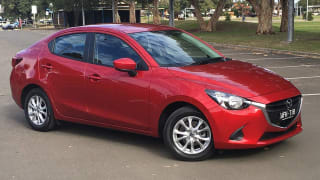
Mazda 2 Maxx sedan auto 2016 review
Richard Berry road tests and reviews the 2016 Mazda2 Sedan Maxx auto with specs, fuel consumption and verdict.
Browse over 9,000 car reviews
Andrew Chesterton road tests and reviews the new Kia Rio with specs, fuel consumption and verdict at its Australian launch in Melbourne.
Saying technology is important to young people is a little like saying water is important to fish. Constant connection is key, and that left the Kia Rio way behind the competition in a segment where trying to sell a model without Apple CarPlay, Android Auto or even a touchscreen is as easy as trying to sell one without a steering wheel.
It was a Nokia 5110 in an iPhone world, and Kia knew it. So the Korean brand has upped the technology stakes for its all-new 2017 Rio, a car it is describing as the “most technologically advanced Rio ever."
A Mercedes S-Class this ain’t, but it does plug some of the most yawning gaps from the outgoing model, the biggest being the inclusion of Apple CarPlay and Android Auto for the first time, which is run through a new 7.0-inch touchscreen designed to look like it’s 'floating' in the dash.
This fourth-generation Rio (Kia’s best-selling car globally) arrives with the same 1.4-litre engine as the outgoing model, offering slightly less power but better fuel economy, which is shared across three trim levels: the entry-level S, mid-spec Si and top-spec SLi.
| Kia Rio 2017: S | |
|---|---|
| Safety rating | |
| Engine Type | 1.4L |
| Fuel Type | Regular Unleaded Petrol |
| Fuel Efficiency | 5.6L/100km |
| Seating | 5 seats |
| Price from | $8,690 |
The 2017 Rio kicks off from $16,990 for the base model S in six-speed manual guise, while opting for a four-speed automatic sees the price jump to $19,090.
For that, you’ll find 15-inch steel wheels, halogen daytime running lights and cloth seats. Outside, expect body-coloured and electric mirrors and a microscopic rear lip spoiler, while inside you’ll get power windows front and rear, manual air-con and a metal-look dash insert. The much-hyped technology upgrade arrives courtesy of the Apple CarPlay, Android Auto-equipped, 7.0-inch touchscreen paired with six speakers and mounted in a newly designed and driver-angled dash.
Stepping up to the auto-only Si trim level ($21,490) adds 15-inch alloy wheels, LED DRLs, front fog lights, a chrome surround on the front grille and heated wing mirrors with an integrated indicator. Inside, you’ll find navigation is now standard, along with cruise control, a chunkier steering wheel and a light for your vanity mirrors.
Spring for the top-spec SLi ($22,990) and your alloy wheels are now 16-inch and you’ll find a sunroof and privacy glass as standard, along with automatic wipers. Inside, you’ll get alloy pedals, a faux-leather seat trim and a dash display for your parking sensors.

Just the one engine available across the Rio range, and it is the 1.4-litre petrol unit carried over from the outgoing model, though de-tuned slightly for better fuel economy.
The engine now produces 74kW at 6,000rpm and 133Nm from 4,000rpm. It’s paired with a choice of six-speed manual or four-speed automatic in the entry-level S, while the automatic is the only option in both the Si and SLi trim levels.
The Rio’s 45-litre tank holds regular unleaded, and C02 emissions are pegged at 129g/km (man) and 145g/km (auto).
The Rio will sip a claimed combined cycle 5.6L/100km (manual) and 6.2L/100km (automatic).
Kia’s Rio has been fitted with a fine European suit for its 2017 assault on Australia’s small-car segment, undergoing a significant exterior reimagining that injects a sense of Euro class into the exterior design.
The Rio’s grille has been reshaped to be both thinner and wider, while the whole car has been given a premium-style makeover, including LED daytime running lights and fog lights on all but the entry-level model.
But that premium feel doesn’t quite extend to the interior. While the 7.0-inch touchscreen, faux-brushed aluminium highlights and chunky steering wheel (in all but the entry-level model) lift the interior ambience, the sea of rock-hard plastic coating every touch point, even in the most expensive model, doesn’t exactly scream premium.
But the figure-hugging seats are supportive and comfortable, the interior layout clean and uncluttered and the ergonomics wondrously sensible.
It’s a tale of the good and bad with the all-new Rio. The steering is fantastic; well-weighted and engaging with enough responsiveness and feedback to inspire confidence on a twisting backroad. Likewise, the locally tuned suspension favours a little firmness over cushioning comfort, and it helps the Kia feel connected to the road below it.
But the bad arrives in the shape of the stodgy 1.4-litre engine and the old-school four-speed automatic that’s standard fit from the mid-spec car and above. Keep it in the city and the Kia hums along easily, breezing from traffic light to traffic light without a care in the world.
Tackle a road with a speed limit of 80km/h or more, however, and you’ll uncover several deep holes in the Rio’s performance. Freeway overtaking manoeuvres need to be planned months in advance, with acceleration from 80-100km/h almost non-existent, while planting your foot and forcing the gearbox to change down a cog or two obliterates the cabin ambience with a loud and annoying whining that eliminates the otherwise good work to minimise NVH interruptions.
But there's a definite and confidence-inspiring solidity to the way the Rio feels from behind the wheel. And it ticks all of the boxes usually associated with a car this size: it's light and easy to drive, the vision is terrific and it's a breeze to park.
The little Rio is far more practical than you might expect, largely due to an expanded wheelbase that allows more room for backseat passengers and a bigger, more accepting boot.
The wheelbase has grown by 10mm to 2580mm, while the car itself has grown by 15mm to 4065mm, and that means there's more legroom than in any Rio before it. Head and shoulder room are commendable, too, though life will be a little less pleasant if you attempt to squeeze three adults into the backseat.
The cupholder count is limited to the two shared between front seat passengers, but every door pocket has room for bottles. And there’s some clever niceties included, too, like the USB charge point for backseat riders and the phone-sized storage space in the dash. There are two ISOFIX attachment points, one for each window seat position in the back.
Luggage space has grown by 37 litres on the old car to a handy 325 litres with the rear seats up, but that grows to 980 litres with the 60/40 seats folded flat.
Basic Warranty
7 years / unlimited km warranty
ANCAP Safety Rating

Kia is shooting for the maximum five-star ANCAP safety rating, and standard kit is commendably identical whatever the trim level. Every Rio arrives with six airbags (two front, two front sides and two curtain), a reversing camera and rear parking sensors as standard, while Hill Start Assist joins two new stability systems, Cornering Brake Control and Straight Line Stability.
AEB is notably absent from every model, however, with the system simply not available on cars fitted with a 1.4-litre engine.
Kia's is still the best in the Australian warranty business, with the Rio covered for seven years and unlimited kilometres, with capped price servicing throughout and service schedules pegged at 15,000km or 12 months.
To put that into perspective, a Rio purchased in 2017 will still be under warranty in 2024. That’s hugely impressive, and Kia deserves to be applauded for it.
Great looking, keenly priced and with an injection of new technology, the all-new Rio ticks a lot of boxes.
For us, the entry-level S is the sweet spot in the range, offering the same engine and technology features as the more expensive models, but for significantly less money.
Click here to see more Kia Rio pricing and spec info.
| Vehicle | Specs | Price* | |
|---|---|---|---|
| S | 1.4L, ULP, 6 SP MAN | $9,240 – 12,980 | 2017 Kia Rio 2017 S Pricing and Specs |
| Si | 1.6L, ULP, 6 SP AUTO | $9,900 – 13,530 | 2017 Kia Rio 2017 Si Pricing and Specs |
| S Premium | 1.4L, ULP, 6 SP MAN | $9,020 – 12,760 | 2017 Kia Rio 2017 S Premium Pricing and Specs |
| Sport | 1.6L, ULP, 4 SP AUTO | $9,900 – 13,530 | 2017 Kia Rio 2017 Sport Pricing and Specs |
| Price and features | 8 |
|---|---|
| Under the bonnet | 5 |
| Efficiency | 7 |
| Design | 8 |
| Driving | 6 |
| Practicality | 7 |
| Safety | 7 |
| Ownership | 8 |
$11,490
Lowest price, based on 82 car listings in the last 6 months